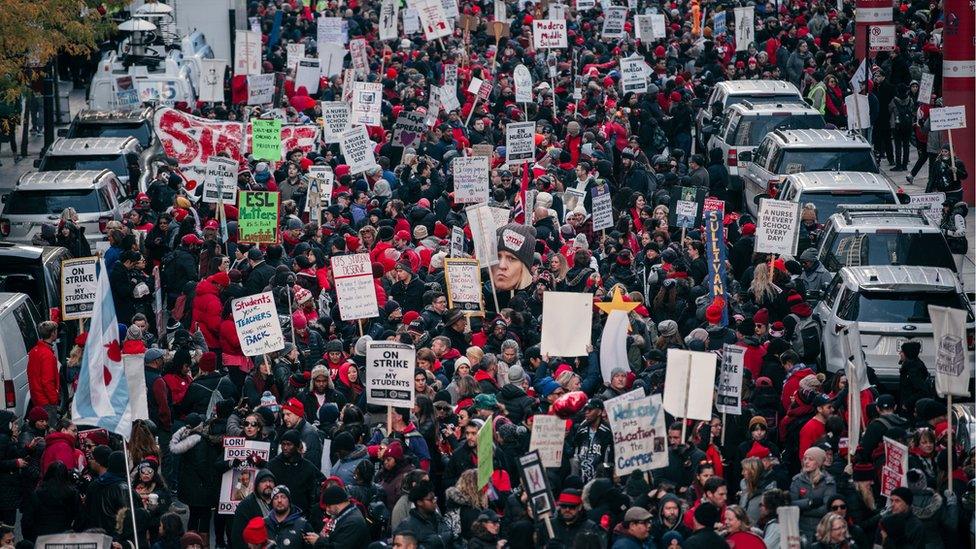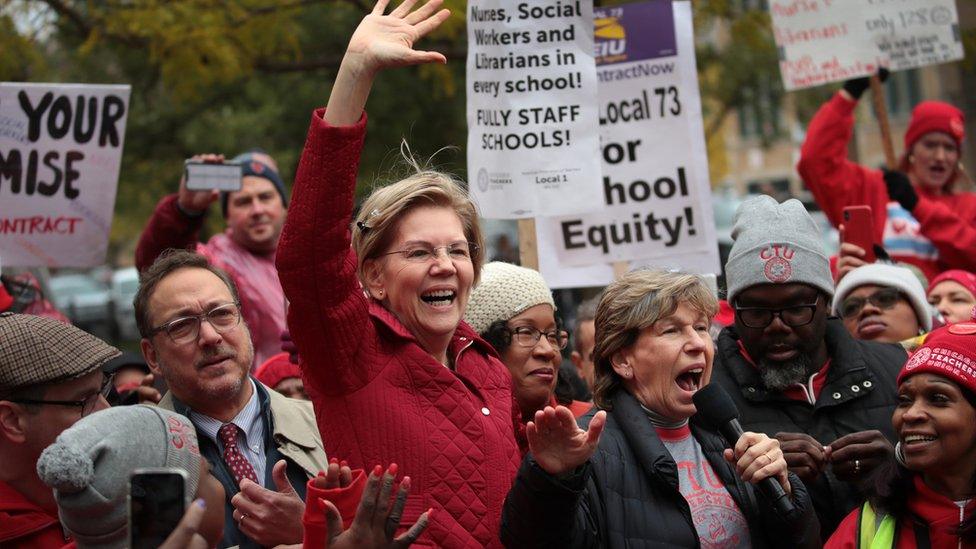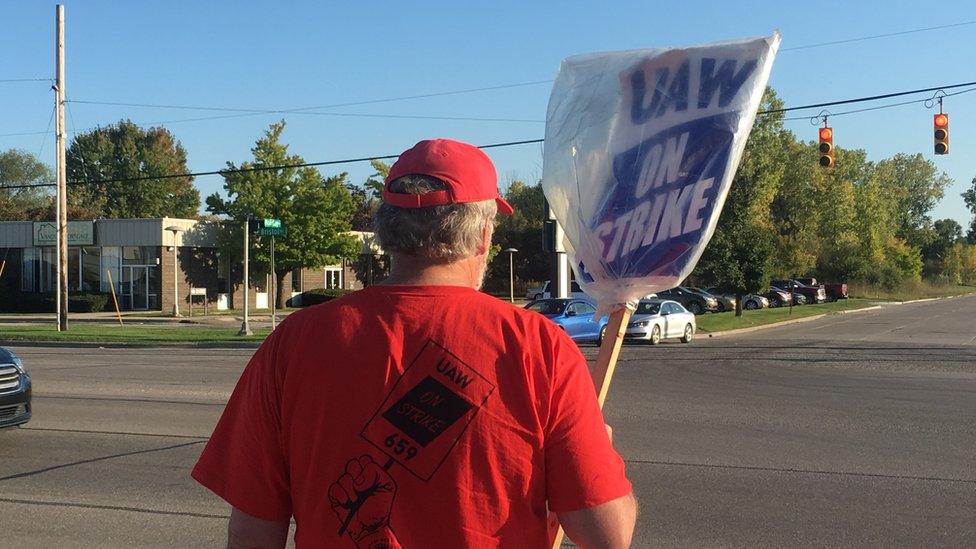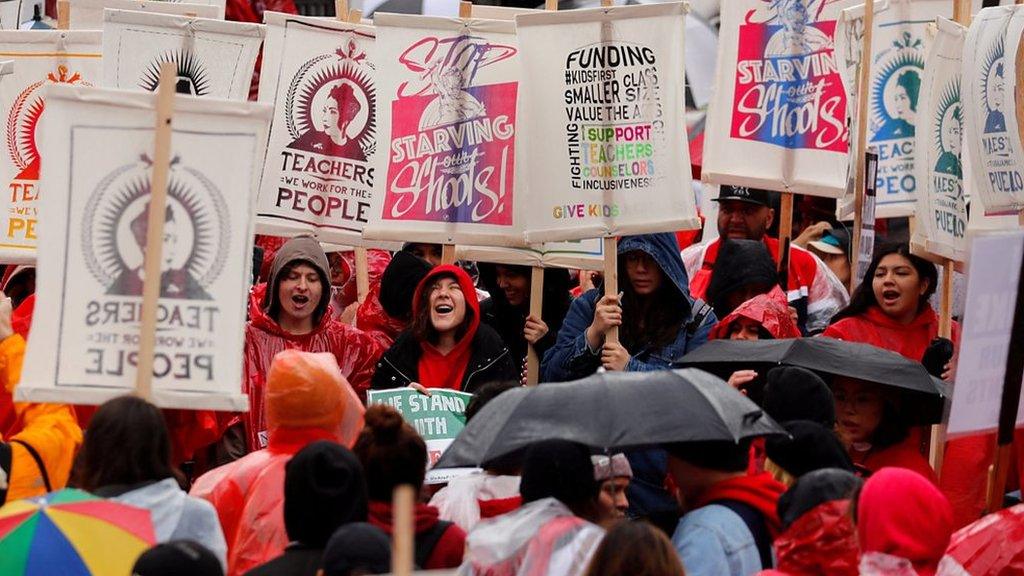Why US teachers have been walking out of schools nationwide
- Published

Thousands have taken to the streets of Chicago in the latest mass teachers' strike
The Chicago teachers' strike - which left more than 300,000 students missing lessons - has ended after 11 days.
The 25,000 teachers went on strike on 17 October, demanding pay raises, resource improvements, school staffing increases and even solutions to the city's pricey housing.
The Illinois city is just the latest in a wave of teachers' strikes that has swept through many US cities.
Last year saw the most US workers on strike in a generation. According to the Bureau of Labor Statistics, external, there were 20 major work stoppages in 2018, involving 485,000 workers - the most since 1986. In a big shift, the most-represented industry was teaching.
Significant state-wide work stoppages in education occurred in West Virginia, Arizona, Oklahoma, Kentucky, Colorado and North Carolina. In January 2019, teachers in Los Angeles - the nation's second-largest school district - went on strike for six days. Smaller strikes have taken place nationwide as well.
Why are US teachers striking?
The strikes are about better working conditions for school staff and better learning conditions for students, according to Eric Blanc, a sociologist at New York University and author of "Red State Revolt", a book about the teachers' strike wave.

Chicago teachers are demanding better pay, smaller class sizes and more support staff
Specific demands may differ, but across the country teachers claim to face many of the same challenges - large class sizes, teacher shortages, low pay and a lack of proper resources. In Chicago, teachers are calling for things like:
Raising teacher salaries
Reducing class sizes
Staffing every school with a nurse and social worker
Adjusting school schedules to add morning preparation time for teachers
Investment in affordable housing by the city
The starting salary of Chicago public school teachers - who are required to live within city limits - is nearly $53,000 (£41,000) under the existing contract, external.
Strikes in other states involved similar issues, with some pointing towards a lack of funding as the root of the problem.
During the financial crisis of 2008, most states cut school funding, according to the Center on Budget and Policy Priorities, external. And while school funding has gradually improved since 2015, most states have not yet recovered to pre-recession levels.
Dr Ileen Devault, labour historian at Cornell University, said the problems started earlier than that, pointing to decades of US tax policy.
"All of the efforts in the US to cut back on taxes - which means cut backs on public funding - has meant that schools have gotten less and less funded," she said, adding teachers have finally reached a breaking point.
Dr Devault also said the strikes are about a lot more than salaries, with teachers demanding a variety of changes needed for schools to run effectively.
Have the strikes been successful?
In early 2018, 35,000 teachers in West Virginia went on strike state-wide for almost two weeks, resulting in a 5% pay raise.
Shortly after, 20,000 teachers across the state of Arizona won a 20% salary raise by 2020 after a five-day strike.
And in early 2019, 30,000 teachers in Los Angeles went on strike for six days, resulting in a 6% salary raise, smaller class sizes and an increase in support staff.
Los Angeles teachers went on strike in January
There have been significant wins in other cities as well.
Dr Devault called the strikes "amazingly successful". She believes the reason for this is that teachers have communicated to the public that they're not just looking out for their own salaries, but for everyone, including students and support staff like bus drivers and nurses.
The spike in strikes might also be a contributing factor to their success. It's given legitimacy and added power to teachers, allowing for them to make more transformative demands.
"There's a national teachers' movement now," Mr Blanc said. "Strikes as a whole are more successful because they're feeding off one another."
What sparked the wave?
The wave may have been sparked in the same city that it's playing out in now. The Chicago teachers' strike back in 2012 sowed the seeds of protest for teachers across the US, according to Mr Blanc.
"Organizers in West Virginia, Arizona, Oklahoma, very consciously looked at that 2012 strike," he said. "They studied the experience of Chicago."
The strike in 2012 - which included pay raises and blocking a programme that would've placed increased emphasis on student test scores - was successful, but much less ambitious than what's been demanded this time round.

Democratic presidential candidate Elizabeth Warren visited striking Chicago teachers to show her support
How do US teacher concerns compare to the UK?
While the recent wave of US strikes has not been matched in the UK, teachers in both countries share many of the same concerns, including pay, class sizes and school staffing.
Earlier this year, the Department for Education announced a 2.75% increase in teachers' pay.
Dr Mary Bousted, joint general secretary of the National Education Union - one of the UK's biggest teaching unions - called the salary increase "fundamentally necessary" to encourage young graduates to pursue teaching and address the teacher shortage facing the country.
Another concern weighing heavily on UK teachers is the workload. A 2018 survey, external by the National Education Union found that 80% of teachers are considering leaving the profession due to the heavy workload, including long hours.
- Published2 April 2018

- Published25 October 2019

- Published15 January 2019
